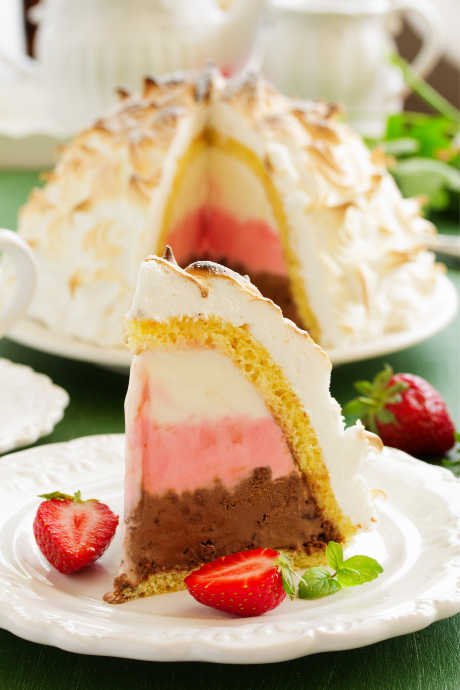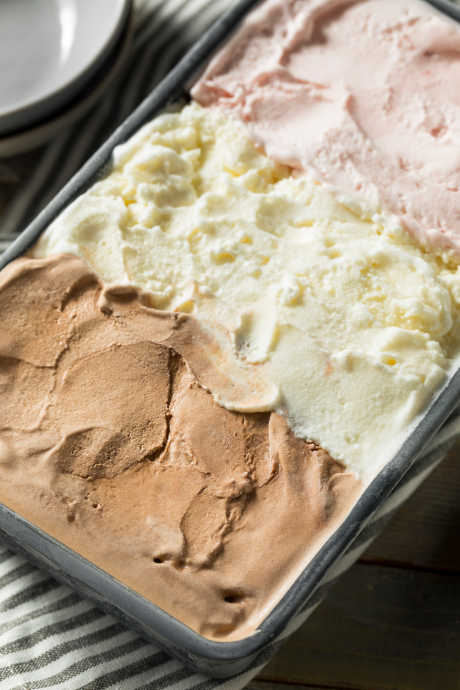Baked Alaska Is One Cool Dessert
Posted by Julie on Jan 31st 2019
We’ve covered the components of Baked Alaska before — ice cream cake and meringue. But making Baked Alaska isn’t as simple as merely combining these two. That is, you can’t cover an ice cream cake in meringue and pop it in the oven. Well, you can, but we wouldn’t recommend it. A successful Baked Alaska involves physics, along with taste and texture.
In honor of Baked Alaska Day on February 1, we’ve explored the details this iconic dessert. Whether you decide to try it in your own kitchen or leave it to the pros, we bet you’ll agree Baked Alaska is one cool dessert.
Basics of Baked Alaska
The true origins of the dessert now known as Baked Alaska remain under debate, but it’s generally agreed the current form was popularized by pastry chef Charles Ranhofer at Delmonico’s, shortly after the purchase of the Alaskan territory by the US in 1867. While the first name — “Alaska, Florida” — appeared in Ranhofer’s 1894 cookbook, Delmonico’s insists that a British journalist visited the restaurant in the 1880’s and dubbed the dessert “Baked Alaska.” Both names refer to the dichotomy of toasted meringue and frozen-solid ice cream in a single creation.
Perfecting Baked Alaska
This series of trial-and-error experiments with Baked Alaska resulted in a dessert that comes together beautifully, serves easily, and that’s truly worth eating. Chef Andrea Geary documented her Baked Alaska journey on Cooks Illustrated. While you’ll need a subscription to get her exact recipe, we think her discoveries can be applied to any Baked Alaska concoction.
Geary went into great detail regarding the physics, taste, and texture of Baked Alaska. One of the conundrums she addressed was how to achieve a balance between the sweetness of the meringue and its insulating properties. The airiness of meringue helps slow the transfer of heat from the oven to the ice cream. If you don’t use enough meringue, the ice cream will start to soften or even melt. But too much meringue makes your Baked Alaska too sweet.
To help insulate the ice cream, Geary wrapped it in a layer of chiffon cake. This approach reduced the amount of meringue required to keep the ice cream cold, which also made the Baked Alaska not as cloyingly sweet.

Geary chose chiffon cake after experimenting with different types of cakes to determine which performed best. Pound cake and brownies were too dense. She tried chiffon and genoise too, and opted for chiffon. A light airy cake offers insulation, but it’s flexible enough to wrap a half cylinder of ice cream.
Finally, to help retain the creamy texture of the ice cream and prevent formation of ice crystals from thawing and refreezing, she used two pints of ice cream laid end to end for a cylinder. Then she cut it in half before encasing it in cake.
While we’re a bit apprehensive at the thought of wrapping cake around ice cream, the photos convinced us this feat is possible. However, we’ll understand if you want to try one of the classic bombe-shaped recipe recommendations below before moving on to Geary’s advanced version.
Baked Alaska Recipe Recommendations
This recipe from Food Network is as simple as it gets, though you still won’t find it easy to cut and serve. Scoop various kinds of ice cream into a metal bowl, cover with crumbled chocolate wafers, and press pound cake slices onto the top. Invert it onto a baking sheet, cover it in meringue, freeze it again, and then bake at 500F to brown the meringue. When you cut, run the knife blade under hot water to keep the slices as clean as possible. Watch the video to see the assembly of this dessert, step by step.

Whether you decide to try your hand at Baked Alaska or not, you ought to read this post on Smitten Kitchen about how Deb introduced her son to Baked Alaska for his seventh birthday. Deb used a brownie base for the cake, but she admits it isn’t easy to cut. Plus, we’ve already covered how brownies don’t offer the same insulation as a light and airy cake. Whip up a round layer of cake (it’s okay if it’s from a box). Cake is an especially good option if you’re not making Baked Alaska for a child who thinks the sweeter, the better. She also gives step by step instructions for flambéing the cake.
Finally, check out this helpful video from Fine Cooking. Regardless of which recipe you choose to try, we love the smart tips here. Chef Julissa Roberts uses a cardboard round as a platform for her layers of cake and ice cream. She cautions viewers to spread the meringue all the way to the cardboard and to make sure there are no bare spots where cake or ice cream are visible, which goes back to the insulating power of meringue we discussed earlier. We also like how she alternates layers of cake and ice cream. The additional cake helps insulate the ice cream and holds the meringue in place.
 Free shipping over $49
Free shipping over $49










